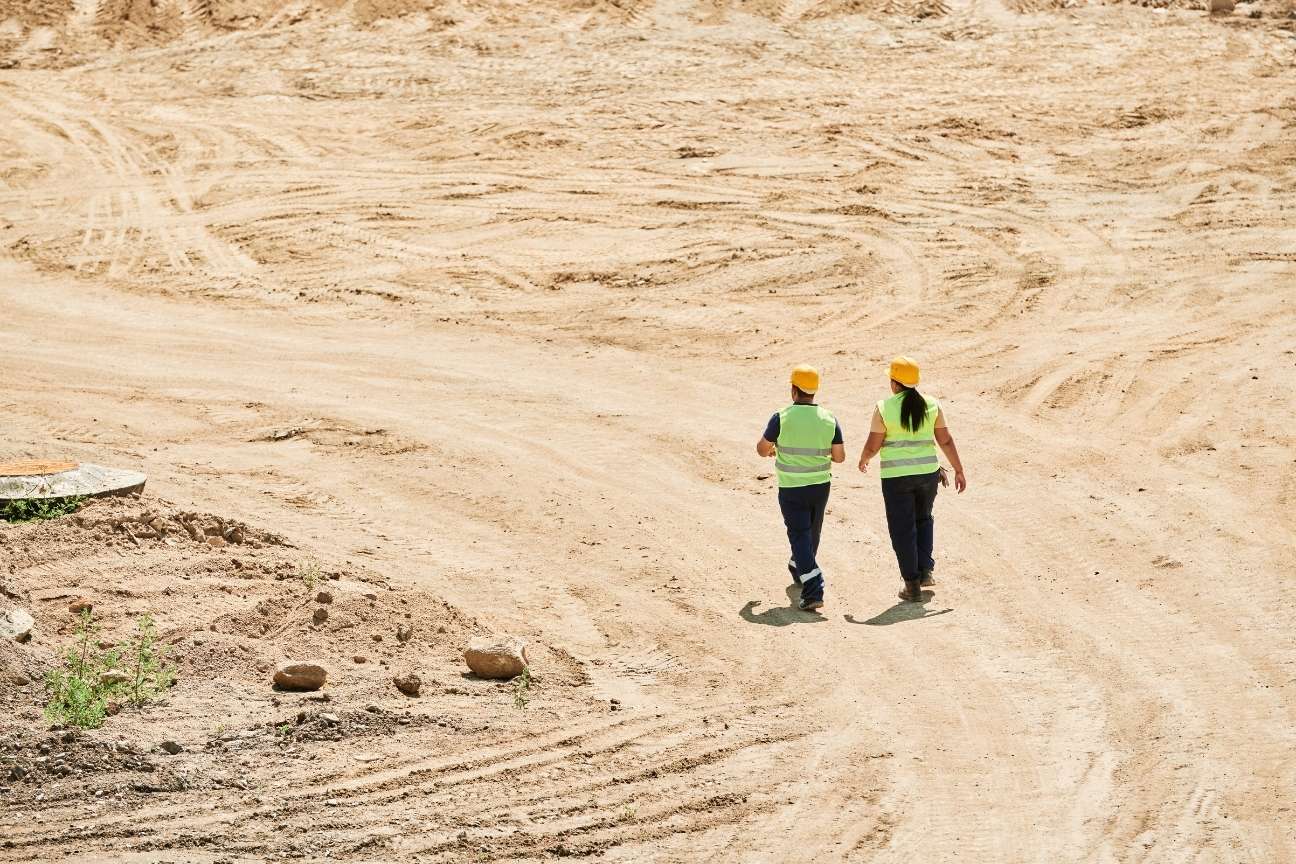Large-scale earthworks are a foundational component of civil construction projects, setting the stage for everything from roads and bridges to buildings and utilities. Without the right equipment, these projects can quickly become inefficient, costly, and risky. This guide provides an overview of the essential equipment for large-scale earthworks and how each piece contributes to the success of heavy civil projects.
Introduction
Large-scale earthworks form the backbone of civil construction. These operations involve moving substantial amounts of soil, clay, and rock to prepare sites for roads, buildings, and infrastructure. When done correctly, earthworks lay a solid foundation. However, without the right equipment, projects can face delays and added costs.
Using the appropriate machinery is crucial for efficiency. Modern earthmoving equipment enhances productivity and reduces risks. For instance, the right excavator can speed up the digging process dramatically. Moreover, selecting the wrong tools can lead to accidents. Thus, ensuring safety is as important as maintaining project timelines.
Understanding this context sets the stage for maximizing project success. Each piece of equipment serves a specific purpose. From excavators to bulldozers, knowing their roles boosts operational effectiveness. Additionally, the right machines can reduce labor costs and improve overall performance.
In this article, we will explore seven essential pieces of equipment for large-scale earthworks. By grasping their functions and applications, contractors can make informed choices. So, let’s dig into the crucial machinery that makes civil construction projects successful.
1. Excavators
Excavators are the backbone of large-scale earthworks. These powerful machines excel at moving earth and preparing sites for construction. Their versatility makes them indispensable on any civil construction project.
Types of Excavators
Excavators come in various types, each suited to specific tasks. The two main categories are wheeled and tracked excavators.
- Wheeled excavators offer versatility and mobility, ideal for urban environments with limited space.
- Tracked excavators provide better stability and traction on rough terrain, making them perfect for heavy lifting and deep digging.
Regardless of type, every excavator features an arm with a bucket or attachment. This design allows for digging, lifting, and moving materials with ease.
Use Cases for Excavators
Excavators shine in numerous applications. They are essential for tasks such as trenching, grading, and digging foundations.
- Trenching: Excavators create deep, narrow trenches for utilities, drainage, and more. Operators can adjust the bucket to reach different depths and widths.
- Grading: With the right attachments, excavators can also level land. This function is crucial for preparing foundations or setting the stage for road construction.
- Digging: Excavators easily penetrate tough soil, making them ideal for deep excavation tasks. They can dig holes for large structures such as buildings, bridges, or swimming pools.
In addition to these applications, excavators provide a foundation for stacking, lifting, and transporting heavy materials. Their unique design and capabilities make them essential in any large-scale earthwork project. With the right excavator at your side, you can tackle any digging challenge effectively and efficiently.
In summary, excavators are vital to the earthmoving process in civil construction. Their variety of types and applications ensures that every construction site can run smoothly and successfully.
Bulldozers
Bulldozers are indispensable in large-scale earthworks. These powerful machines effectively push and shape earth, making them a cornerstone of civil construction projects. Whether you’re grading a site or moving soil, a bulldozer gets the job done efficiently.
Key Features of Bulldozers
The design and features of a bulldozer can greatly influence its performance. Two primary blade types set bulldozers apart:
- Straight Blades: Offer precision in grading and leveling.
- Angle Blades: Excel in pushing material sideways, making them perfect for spreading soil.
Traction Types
Traction is another crucial feature to consider. Most bulldozers come in two designs:
- Tracked Bulldozers: Provide superior traction on uneven terrain.
- Wheeled Bulldozers: Offer better mobility on smoother surfaces.
Use Cases for Bulldozers
In earthworks, bulldozers serve multiple vital functions. Here are common scenarios where they shine:
Grading: Bulldozers effectively level large areas of land, essential for preparing sites for construction. They can move significant amounts of soil quickly, saving time and labor costs.
Material Movement: Need to relocate earth? Bulldozers are built to push immense quantities of soil, ensuring efficient material handling.
Site Preparation: Before laying foundations, a bulldozer sets the stage. It clears debris, removes obstacles, and creates a uniform base for construction activities.
- Reclamation: In environmental projects, bulldozers help reshape landscapes and restore land. They can spread and manipulate soil for better ecological balance.
Making the Right Choice
Choosing the right bulldozer is crucial for your project’s success. Consider the following when making your selection:
- Evaluate Site Conditions: Understand the terrain you’ll be working on.
- Determine Volume of Work: Assess the amount of material you’ll need to move.
In conclusion, bulldozers are more than just machinery; they are key players in successful large-scale earthworks. With their versatility and power, they ensure that every earth-moving challenge is met head-on.
3. Dump Trucks
Dump trucks play a crucial role in large-scale earthworks for civil construction. These machines are designed to efficiently transport various materials, including soil, gravel, and debris. Given their versatility and capacity, they are indispensable for any excavation project.
Types of Dump Trucks
Understanding the different types of dump trucks helps in selecting the right one for your project:
Standard Dump Trucks: These are common on most construction sites. They have a fixed cab and an open box bed, making them suitable for moving loose loads.
Articulated Dump Trucks: These trucks feature a pivoting joint between the cab and the dump box. This design allows for better maneuverability and helps navigate uneven terrain.
Each type has its own load capacity and operational strengths, allowing operators to optimize their performance.
Use Cases for Dump Trucks
Dump trucks are not just for transporting materials. They serve various purposes in civil construction projects:
On-Site Material Movement: When excavators dig trenches or move earth, dump trucks quickly transport that material away. This keeps the site clear and organized, enhancing overall efficiency.
Off-Site Transportation: For projects involving large volumes of dirt or debris, dump trucks are essential for hauling materials to disposal sites or other locations.
Site Preparation: When starting a new construction site, dump trucks carry in materials like gravel or fill dirt, ensuring a solid foundation.
4. Graders
Overview
Graders play a crucial role in large-scale earthworks by creating flat, even surfaces. These machines are designed to smooth and shape terrain, which is essential for preparing construction sites, roads, and ditches. A well-graded surface sets the foundation for a successful construction project.
Key Features
One of the standout features of graders is their adjustable blades. Operators can tilt, angle, and raise or lower the blades to achieve the desired finish. This flexibility allows graders to effectively manage contours and drainage. Moreover, many modern graders come equipped with GPS technology. This ensures precise leveling, which enhances the overall quality of the project.
Use Cases
Graders are invaluable in several applications. For instance, when preparing a new roadway, graders ensure the surface is evenly layered for asphalt or concrete. This helps prevent future cracks and potholes. Additionally, graders assist in shaping drainage ditches, directing water away from the construction site.
Another common use is in grading foundations for buildings. A level surface is critical for structural integrity. Operators rely on graders to ensure that the groundwork is solid and uniform.
In summary, graders are essential in the earthworks phase of civil construction. Their ability to create smooth, stable surfaces makes them a vital piece of equipment for any large-scale project. Whether for roads or structures, investing in quality graders is a smart move for construction efficiency and success.
Compactors: Essential Tools for Earthworks
Compactors play a crucial role in large-scale earthworks. They ensure that soil and other materials are sufficiently compacted for stability. Proper compaction is vital for building foundations and road surfaces that can withstand heavy loads. Let’s delve into the types of compactors and their specific applications in civil construction.
Importance of Soil Compaction
Soil compaction increases the load-bearing capacity of the ground. This process provides several benefits:
- Reduces the risk of settling or shifting after construction.
- Provides a solid base for structures, preventing costly repairs down the line.
- Manages water drainage, enhancing site stability.
Well-compacted soil ensures that structures remain stable over time. Therefore, investing in proper compaction is essential for any construction project.
Types of Compactors
There are several types of compactors, each serving unique purposes:
Vibratory Compactors
- Operate using vibration to enhance soil density.
- Ideal for asphalt and granular soils.
- Effective in reaching higher compaction levels quickly.
Static Compactors
- Function without vibratory action.
- Best suited for cohesive soils like clay.
- Use weight to compress soil instead of vibration.
Pneumatic Compactors
- Equipped with rubber wheels.
- Apply pressure evenly across the surface.
- Work well on various surfaces, especially asphalt.
Use Cases for Compactors
Compactors are indispensable during multiple phases of construction. Here are a few key use cases:
Foundation Preparation
Before laying the foundation of a building, compaction ensures a stable base. This stability helps avoid future structural problems.Road Surface Preparation
Compaction enhances the durability of the pavement, ensuring it can handle traffic loads efficiently.Utility Projects
Compacting trench backfill helps prevent future subsidence, maintaining the integrity of underground utilities.
6. Scrapers
Scrapers play a crucial role in large-scale earthworks. They are designed to remove and transport material efficiently across construction sites. Whether you’re leveling land or creating slopes, scrapers get the job done quickly and effectively.
Types of Scrapers
There are two main types of scrapers: open bowl and elevator scrapers.
Open Bowl Scrapers
Open bowl scrapers have a large, open front that collects material as they move. They can hold a substantial amount of earth, making them ideal for simple grading tasks. These scrapers work best on flat or gently sloping terrain. You can find them on many construction sites, from road projects to residential developments.
Elevator Scrapers
Elevator scrapers are more sophisticated. They feature an enclosed design with a conveyor system that lifts material to a higher point. This design is advantageous when moving earth uphill or loading into trucks. Elevator scrapers are perfect for projects requiring precise material movement or where space is limited.
Use Cases for Scrapers
Scrapers excel in several applications. One common use is in earth moving for road construction. They efficiently cut, transport, and spread materials in a single pass. This reduces the need for multiple machines, saving both time and labor costs.
Another significant application is in landscaping. Scrapers help shape large fields or construction sites by moving material to create desired slopes and levels. They effectively remove excess dirt or fill low areas to achieve a planned site design.
In addition, scrapers are often used in reclaiming land or moving materials for large grading projects. Their ability to cover vast areas makes them indispensable in civil construction.
In conclusion, scrapers are essential for effective material removal and transportation. Understanding the differences between open bowl and elevator scrapers helps you choose the right tool for the job. Whether you are grading roads or shaping landscapes, incorporating scrapers into your earthworks can enhance project efficiency and productivity.
7. Trenchers
Trenchers play a critical role in large-scale earthworks, particularly when digging trenches efficiently. These machines are specifically designed for this task, making them invaluable for multiple civil construction projects. From laying utility lines to managing drainage, trenchers streamline operations effectively.
Types of Trenchers
There are two main types of trenchers:
1. Wheel Trenchers
- Wheel trenchers utilize rotating wheels equipped with sharp blades.
- They excel at cutting through soil and rock, particularly softer materials.
- These machines create narrow trenches quickly, making them efficient for specific tasks.
2. Chain Trenchers
- Chain trenchers feature a continuous chain with sharp teeth.
- This design enables them to dig deeper and wider trenches.
- They are ideal for handling tougher ground conditions.
Each type has advantages based on project requirements and soil conditions.
Use Cases for Trenchers
Trenchers excel in various applications, including:
- Installing Water and Sewer Lines: Their precision and speed significantly reduce trenching time.
- Creating Drainage Systems: Properly designed drainage prevents flooding and ensures site stability.
- Cable Installation: Whether for telecommunications or electrical services, trenchers create reliable underground pathways.
Conclusion
Large-scale earthworks rely heavily on the right equipment. Each piece plays a crucial role in accomplishing project goals efficiently and safely. Let’s revisit the key players and their significance.
Excavators are indispensable for digging and site preparation. They provide versatility, whether you need wheeled or tracked models. On the other hand, bulldozers excel at pushing and shaping terrain. Their blade types help in maneuvering through various soil conditions.
Dump trucks facilitate the efficient movement of materials. With options like standard and articulated models, they easily adapt to different site activities. Graders bring precision to surface creation. Their ability to adjust blades allows for smooth and level ground, making them vital for construction sites and roadway projects.
Compactors are essential for soil stability. They ensure that foundations and road surfaces can withstand future loads. Scrapers assist in material removal and transportation. Their efficiency in moving earth saves time and labor.
Finally, trenchers are crucial for digging trenches efficiently. Whether for utilities or drainage, they simplify a task that could be significantly challenging otherwise.
Best Practices for Equipment Selection
When choosing equipment, consider several factors. First, determine the specific needs of your project. Assess the soil types, the project’s scale, and the materials you will be working with. If possible, test equipment for performance and comfort. A well-chosen machine can enhance productivity and minimize downtime.
Maintenance Matters
Regular maintenance is key to prolonging the life of your equipment. Create a schedule for inspections, servicing, and repairs. Well-maintained machinery not only runs better but also reduces safety risks on-site. Train your operators to recognize early signs of wear or issues.
The Future of Heavy Equipment
Innovation in civil construction is transforming equipment use. Technologies like automation and GPS tracking are shaping how operators manage heavy machinery. Stay informed on these advancements. They can lead to significant gains in efficiency and safety.
In summary, the right equipment is a foundation on which civil construction projects are built. Evaluate your needs carefully, maintain your machines, and embrace innovation to enhance your project’s success.







